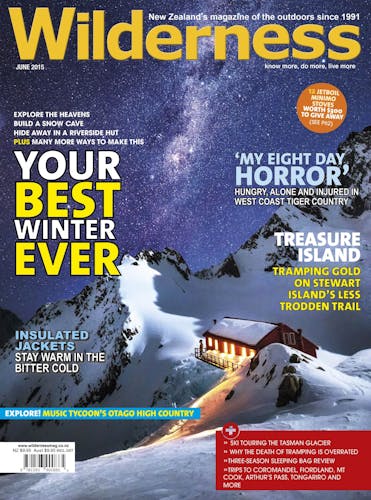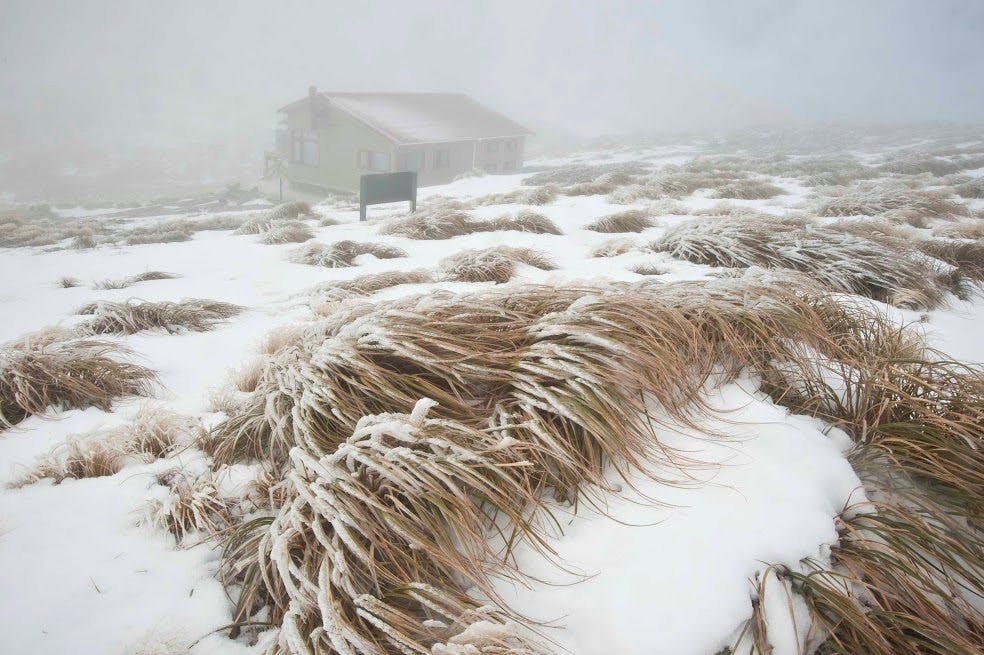Shaun Barnett contemplates advancing age and cold huts
July 2014: the forecast was for snow above 1000m, and I imagined wandering around the slopes of Mt Taranaki, light snowflakes falling softly out of a steel-grey sky. Instead, we got only a few meagre flakes; the rest was a mixture of sleet and freezing rain.
No one else was foolish enough to have tramped into Holly Hut, and although there was coal aplenty, kindling was in short supply. After several hours of hyperventilating, and an inordinate amount of effort, we got the fire hot enough for the reluctant coal to burn. But in such a large, empty space this warmed only about a square metre around the wood stove. I slept wearing every fibre of clothing I’d carried.
August 2014: curiously enough, the Tararuas had the best mountain forecast for the North Island. We planned a trip to the new Kime Hut, hoping the easterly was not strong enough to lap over the divide. It was a forlorn hope; while Field Hut was drenched in sun, higher up the murk descended and horizontal sleet bit at our faces, hands and bare legs. When we reached it, the new Kime Hut was frigid and my mate Dave Hansford exclaimed in shock, “Where’s the wood stove?”
My other companion, Dave Chowdhury, later commented somewhat waspishly that it seemed like DOC had bought a Soviet mental institution cheap from Siberia and installed in on the Tararua tops. Inside, Chowdhury and I wore down jackets and our sleeping bags. Hansford deeply regretted forgetting his down jacket, but decided not to wear his sleeping bag in fear of having nowhere warmer to retreat to after dark.
Our breath steamed and gradually the hut became encased in rime ice. Having endured bitterly cold nights in the previous Kime Hut, I couldn’t help thinking that 80 years of hut design hadn’t advanced much.
Both these experiences in large, cold huts got me thinking about two things: advancing age, and hut design. As we get older, our ability to tolerate cold seems to decline. I remember, with horror, the lack of clothes I used to carry when I first started tramping nearly 30 years ago. I would wear cotton inside the hut or camp, and certainly never had a down jacket. Sure, I had some cold experiences, but it just didn’t seem to matter as much.
Built in 1975, Holly Hut is a Lockwood hut with no insulation or double glazing, but the thickness of the wood provides some ability to retard heat loss. But it’s a large 28-bunk hut, and an unfortunate design feature means the four bunk rooms have an open ceiling space so it’s impossible to seal off the main living area and heat it adequately.
Although Kime is a large, modern hut, with double glazed windows and full insulation, without a heating source these modern design features only lock the cold in. Other popular huts above the bushline such as Powell, Jumbo, Longview, Sunrise and Rangiwahia have heating. Should Kime have some form of heating too?
Having the hut warm would help it stay drier and perhaps prolong its life. Kime is $5/night, and I’d happily pay $15 for some heating. But I appreciate that even this price hike would not cover the cost of providing wood or gas, even without the question of burning fossil fuels in a world facing climate change.
When I paid hut fees at North Egmont, I was told plenty of wood is flown to Holly Hut, but people burn it all instead of using it just as kindling. So DOC faces a management dilemma; provide fuel and people are profligate with it, meaning higher costs and potentially escalating hut fees. Provide nothing and cold trampers will complain, or not bother to go at all.
Most of the people we met in the Tararuas stayed at Field Hut (where there is a wood burner) and ventured only as far along the tops as the sun reached. Sensible people. We were the only ones stubborn enough to trudge on to Kime.
Maybe age has made me less tolerant of cold; but it’s certainly not made me much wiser.








